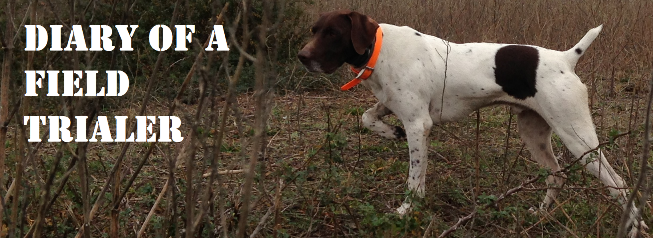There are
certain things you will want to have if you are field trialing your pointing
dog. Below are some of the items I have with me at every contest we go to.
O-Ring Dog
Collar – As opposed to a D-ring Collar there is nothing hanging down or
protruding from an O-Ring collar. This for me is just a simple safety issue
that can prevent my dog from being caught by a collar ring on a fence or brush
for some undetermined amount of time. I personally get mine from Lion Country
Supply because they can be bought with a nice brass name plate already installed. Click here for the collars I use.
Reflective
Neck Band or Field Trial Collar – A dog in a field trial may only have on 2
collars. For most one is a GPS collar. The other is either a reflective collar
of red or green or a red or green field trial collar. Each dog is assigned a color
or red or green depending on draw position in the brace. And short of running
against a different breed dog the collar is usually how they are distinguished.
For me the reflective band is easiest to see, but there are a host of options.
Blank Pistol
– Birds are not normally killed on course and not often in training either. So
a blank pistol is needed. They come in a variety of prices from $80 to $300 but
be sure NOT to buy a .22 crimp. These pistols are usually around $30 and NOT
allowed in AKC field trials. Full .22 like those used for nail guns are
allowed.
GPS Collar –
This is an expensive item but I would say a must. Fortunately I have not been
to a field trial where someone was not willing to loan me one for my brace.
Second the newer the dog is the more likely I would say that they have an very
good opportunity to get “lost.” The grounds may not be familiar to the dog, and
game or other distraction can send them running a great adventure rather than
the field trial. The GPS Collar is good insurance.
Crate – Dog crates
come from under $100 to custom trailers worth tens of thousands. This is all
personal preference, but I would say a crate is a must if only for
transportation. There are also lots of manufacturers of the nicer aluminum crates/dog
boxes like Owens, Deer Skin, and others.
Stake Out –
This metal stake with its swivel and chain allows you not have to keep your dog
in a crate or on a leash securely. They are driven in with a hammer so bring
one of those, but pull up fairly easily with only your hands.
Bowls – It goes
without saying bring your dog’s food and/or water bowl(s)
Lead – This is
a personal preference in terms of how you bring your dog to the line, and
whether they will heal or not. And believe it or not there are a lot of dogs
that drag their handlers to the line. A
second long lead will be needed in case your dog is picked up (disqualified).
At that point you will need to “collar” your dog and take him back to camp. So
unless you want to walk along side your horse with your dog on a lease you will
need a 15’ – 20’ lead to bring them back. NEVER TIE THIS OFF TO THE HORSE IN
ANY WAY. Always hold it in your hand so that you can let go if the dog and/or
horse get into trouble.
Roading
Harness – Many handlers use a roading harness when their dogs are picked up.
They carry it with them attached to their saddle for this event. The roading
harness keeps the dog from being attached at the neck and is another safety precaution
as man, dog, and horses interact.
Training is not allowed on field trial grounds so we will
cover some training gear in another post. In the meantime below are some links
of just a few of the places I shop for gear for me and my dog. Please add any
places you like to the comments below.
Gun Dog Supply
Deer Skin Dog Boxes
Owens Dog Boxes





